04 january 2024, Wouter van den Eijkel
From figurative to abstract and back again: it's not a journey that many artists take. Dutch artist Mirthe Klück doesn't see a significant distinction between the two and creates both abstract paintings and sculptures. "In the end, you're looking at glued-together bits that evoke a feeling or thought, whether cast in a recognisable figure or not." This has resulted in a versatile body of work based on Klück's idiosyncratic observations of everyday things. From a gummy bear and spit-out piece of chewing gum to the wrapper of a chocolate Easter bunny, she explores how layers of matter interact to create a surface that feels both familiar and strange. At Art Rotterdam, FRED&FERRY Gallery is presenting an overview of Mirthe Klück's work.
Congratulations on your presentation at Art Rotterdam. What can we expect?
Thank you! I'm excited to showcase a comprehensive overview of my work at an exhibition with FRED&FERRY Gallery. I'll be presenting a combination of more abstract paintings and figurative ceramic sculptures. They all incorporate recognisable motifs and materials from my daily life, transformed into something wondrous and alien based on my own interpretation. I'm guided by painting techniques and ceramic glazes that I find interesting for formal reasons, making the creation journey of the image of intrinsic importance.
What kinds of recognisable motifs and materials are you referring to?
The ceramic sculptures, for instance, are enlargements of a gummy bear and chewed pieces of gum. When I saw a pink spit-out piece of gum on a rosy marble sculpture in Italy last year, I suddenly saw the sculptural qualities of such a form. Chewing gum essentially creates a mould of your teeth. In my paintings, I choose textile materials like curtains, carpet backing and sunscreens as supports. I sometimes add almost nothing to a fabric, but incorporate it by tearing it and creating a composition or simply by stretching it. This may sound inconsistent, but in all these works, I explore how layers of matter interact to create a surface that feels both familiar and strange.
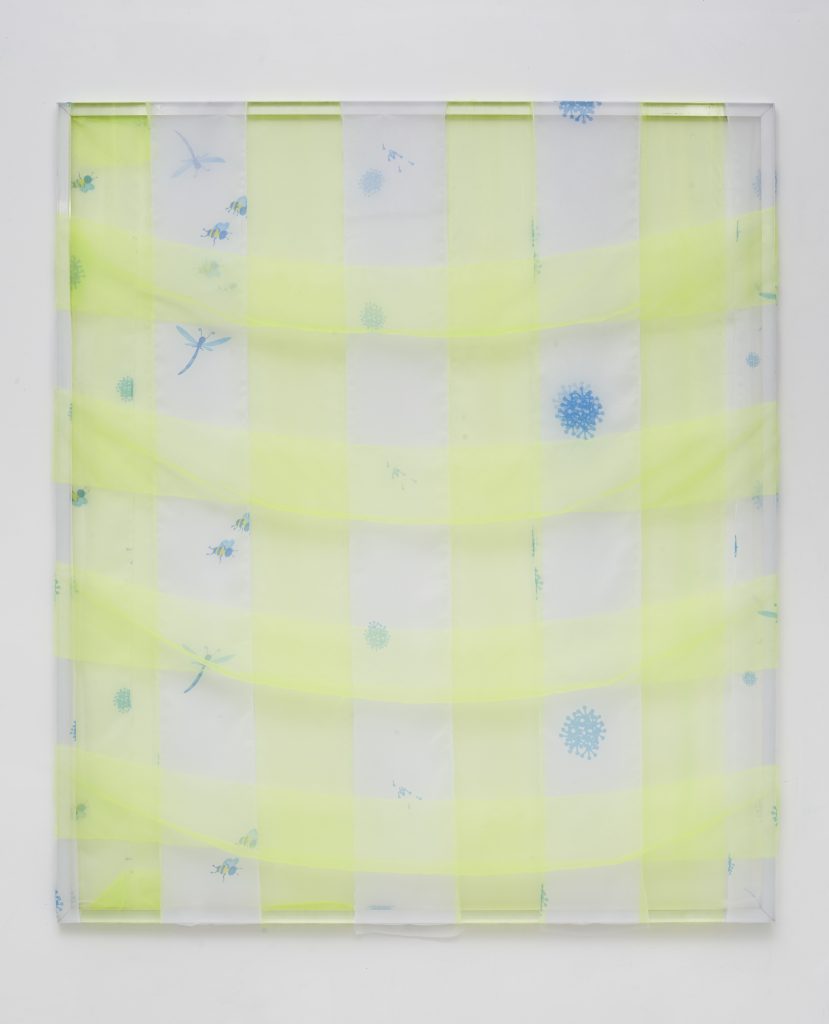
Mirthe Klück, Aerosol, 160x140cm, 2021, FRED&FERRY
Do you consider this presentation a logical continuation of your previous work or have you embarked on a new path?
This presentation is in fact a continuation of my solo exhibition Moon White Rabbit, which I presented at FRED&FERRY at the end of 2021, which was the first time I showcased both paintings and ceramics. For years, I've been creating two-dimensional work that responds to the medium of painting. My first ceramic sculpture, Blue Moon (2021), originates from such a conceptual work, specifically the silkscreen on aluminium foil I'll be Your Mirror (2018), for which I enlarged a package featuring a Easter bunny that is painting.
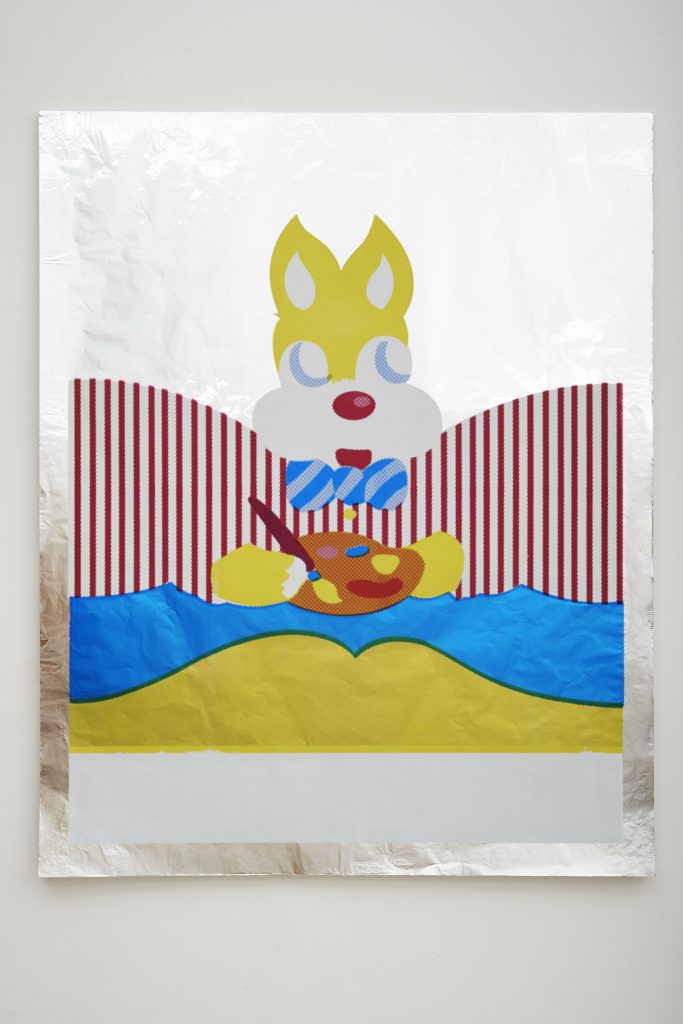
Mirthe Klück, I'll be your mirror, 125x100cm, 2018, FRED&FERRY
The sculpture is an enlargement of the chocolate itself. I found ceramics appropriate due to the similar properties of chocolate and casting clay, such as their creaminess and how easily they transition between liquid and solid phases. The title refers to the glaze: the blueish green Jun glaze is a type of celadon that in China referred to jade stone and The Jade Hare is folklore based on moon markings resembling a rabbit.
The Jun glaze is said to have molecules similar to those causing the Rayleigh scattering in the air, making our sky appear infinitely blue. This brings the glaze closer to the natural phenomenon than paint alone can mimic. Last winter, during a residency at the EKWC, I began focusing more on ceramics. This process resulted in several sculptures that I will be presenting at Art Rotterdam, along with paintings influenced by this process.
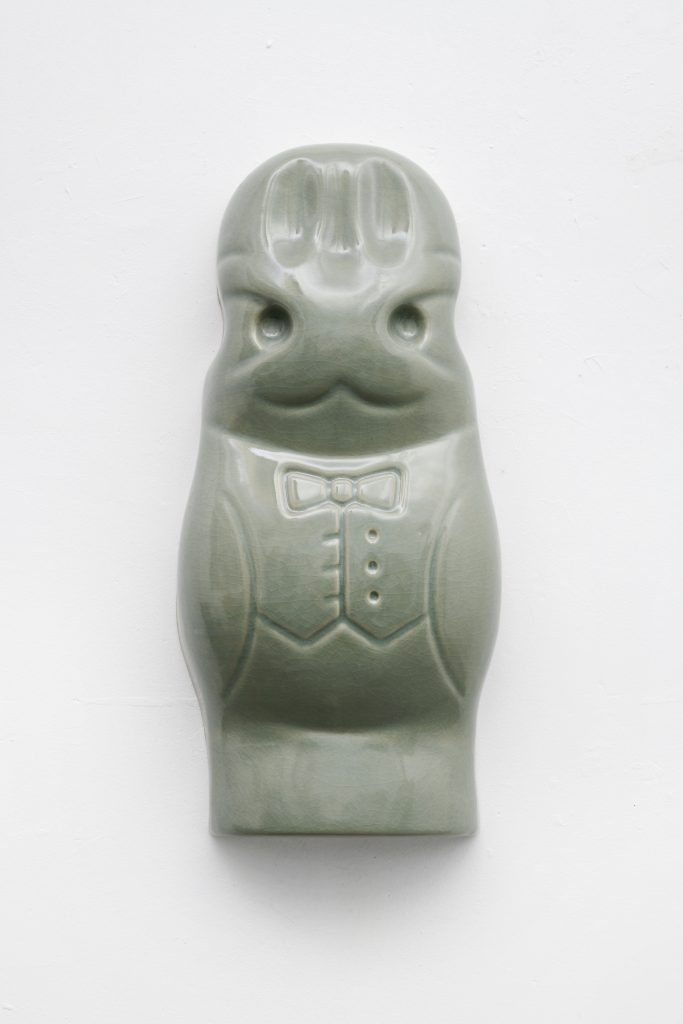
Mirthe Klück, BlueMoon, 70x35x15cm, 2022, FRED&FERRY
Out of curiosity: you initially worked abstractly and later also figuratively. Normally, this is a significant shift in someone's work, but I imagine that for you, the difference between abstract and figurative isn't that considerable. Is that correct?
Yes, that's correct. I don't see a fundamental difference. In the end, you're looking at glued-together bits that evoke a feeling or thought, whether cast in a recognisable figure or not. I use figuration more to introduce certain shapes, colours and associations. All the same, I am selective about which figures I use because it should provide just enough without becoming narrative or expressive.
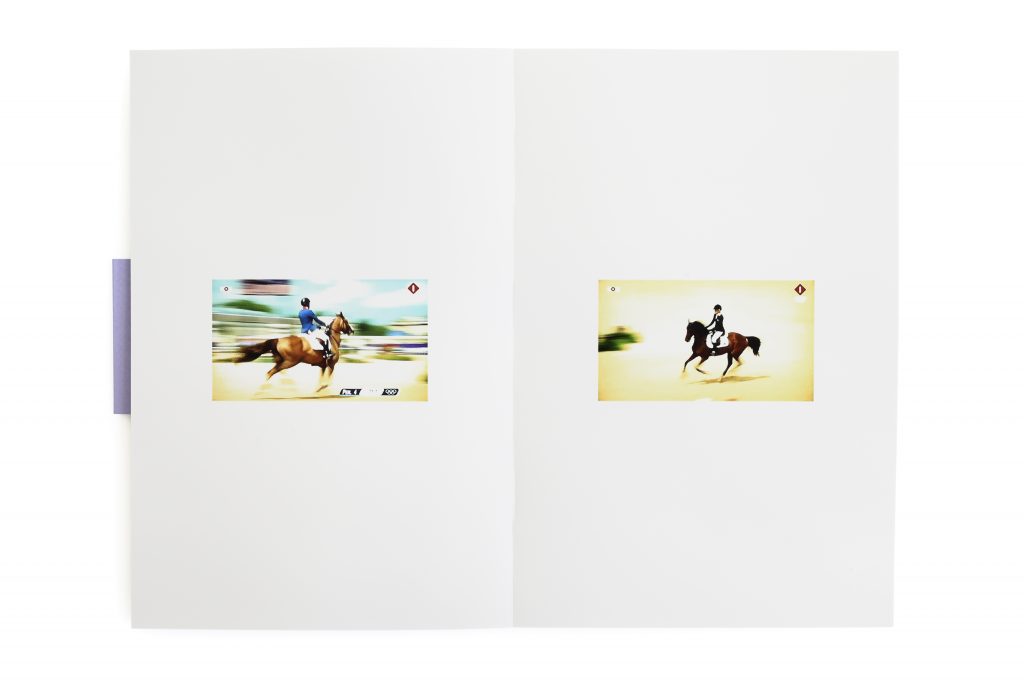
Mirthe Klück, Horses, artist book, 2021, FRED&FERRY
Most people may know your work from Horses in 2021, featuring photos of the equestrian jumping event at the 2012 Olympics. You didn't take the pictures in the stadium, but in front of the TV with your phone. How did this idea come about? Why did you decide to approach it this way rather than choosing stills from a recording?
The idea came about very intuitively. I simply grabbed my phone while watching the Olympic Games on a lazy summer day, curious to see if I could capture one of those floating horses over those artistic obstacles with all those graphic logos in the corners of the screen. Then I saw that my phone rendered it beautifully. The saturation of colours and selective focus made them resemble contemporary impressionistic miniature paintings, reminding me of Muybridge, Degas, cowboy comics and games like Zoo Tycoon. They also emphasise the absurdity of such an event. Somewhere in the world, horses have to jump over artificial obstacles in a very staged environment. This is captured by various equipment, transmitted via satellites to our TV screens in a live broadcast to give us a feeling of being there.
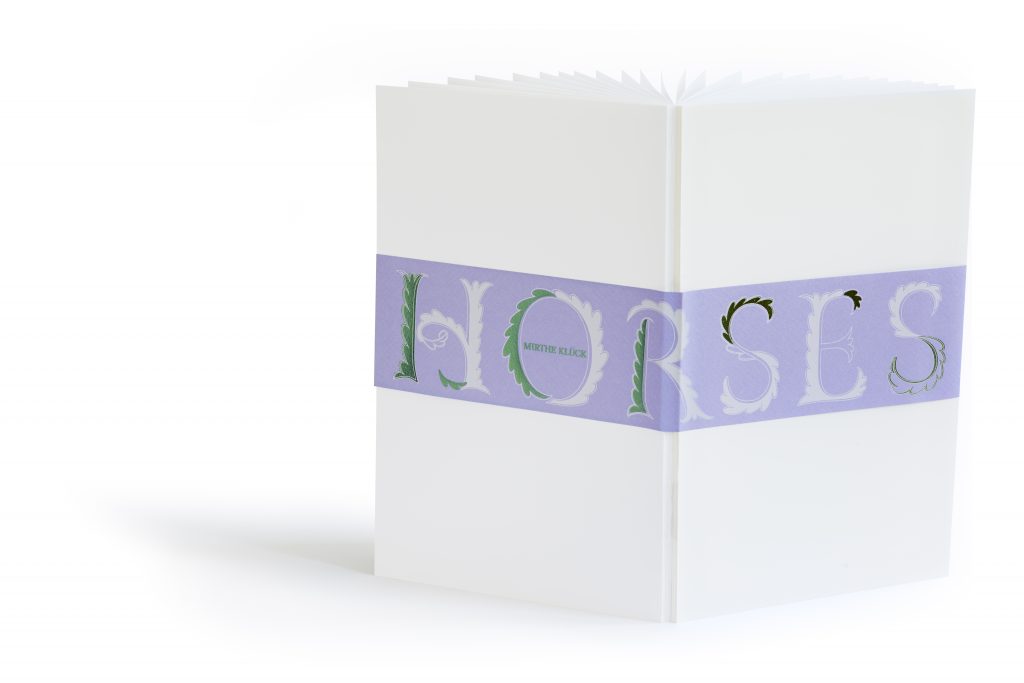
Mirthe Klück, Horses, artist book, 2021, FRED&FERRY
Since 2012, this trend of experiencing things through screens has only intensified. By taking the photos and printing them in a book, I add more layers to my subjective experience. It was actually quite challenging to reproduce the aesthetic quality of my glowing phone screen on paper. So, the pages of the book consist of digitally developed photos because c-prints also use the RGB colour scheme and layers of chemicals create the colour. Quite similar to a painting or ceramic glaze.
You have a keen eye for seemingly insignificant details and your work has a certain lightness/humour to it, which is why it is sometimes compared to that of Daan van Golden. Is he one of your influences? Who are others?
Yes, Daan van Golden has been my greatest influence after leaving his exhibition at GEM in 2014 feeling very happy. I thought, if art can evoke this feeling, I hope my work can do the same for someone else someday. There are various artistic practices and works that I appreciate, such as those of Lily van der Stokker and Klaas Kloosterboer, but I haven't come across an artist to whom I feel as connected as to Daan van Golden. It's mainly because of the feeling I get from his work, although I can't explain it in simple terms. It's a basic sense of understanding. I must admit I've somewhat let go of this fascination, or perhaps obsession, in the past few years because I need to move forward with my own life. But I think we have a similar way of perceiving things.
Others must notice the playfulness in your work. What is the best compliment you've ever received about your work?
Well, it's hard to choose the best one. Personally, I really appreciate receiving compliments from other artists or when people develop a kind of personal connection with my work. They don't necessarily have to have it hanging on their wall at home. For instance, someone I didn't know at the time showed me that he had a painting of mine as a screensaver on his phone. But it's always interesting and funny to see how people react to my work. I often hear that people want to touch it, even though that is not my intention.
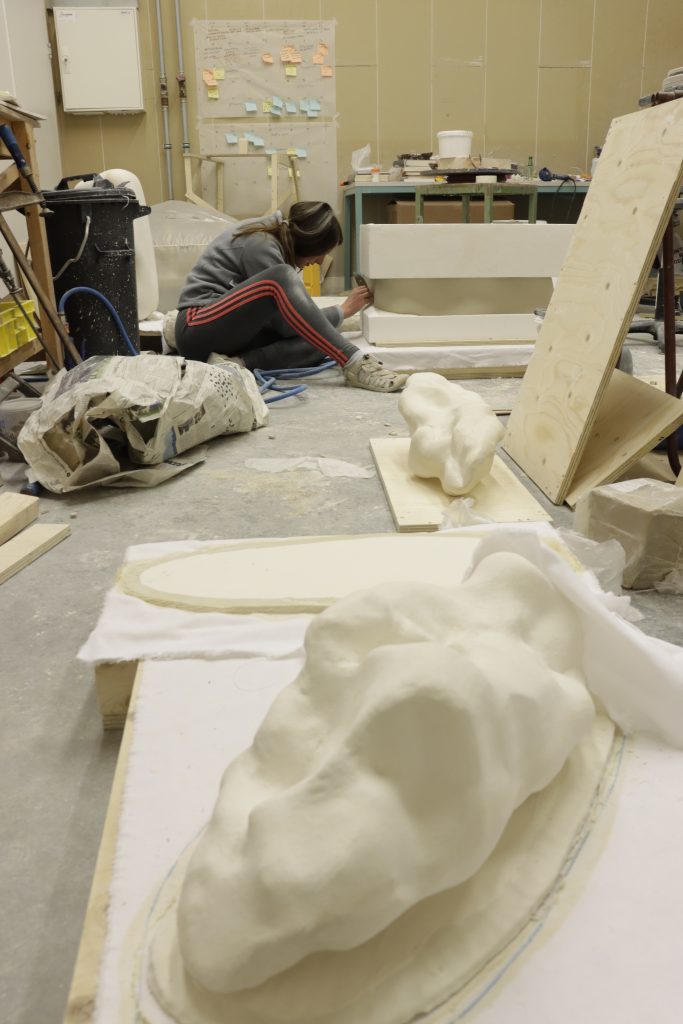
Atelier Mirthe Klück, photo: Maaike Kramer
What are you currently working on?
In January, I'm be curating a group exhibition at FRED&FERRY in Antwerp called Mountain Friends. For this exhibition, I'm selecting specific works by Daniele Formica, Kaï-Chun Chang, Maja Klaassens and Nishiko, which resonate with my work. All these works are poetic translations of everyday objects and elements. Broadly speaking, this exhibition is about the illusory difference between what is natural and artificial. I'm also preparing for a residency I'll be doing in the summer - the Creative Residency Arita in Japan - thanks to the support of the Mondriaan Fonds. The village of Arita is internationally known for its expertise in porcelain, a material that is very challenging to work with. I'm really looking forward to this. Right now, I'm trying to learn some Japanese and am busy implementing the ceramic techniques I learned at the EKWC into my studio. After January, I'll delve into more theoretical research on Japanese culture and ceramics.

